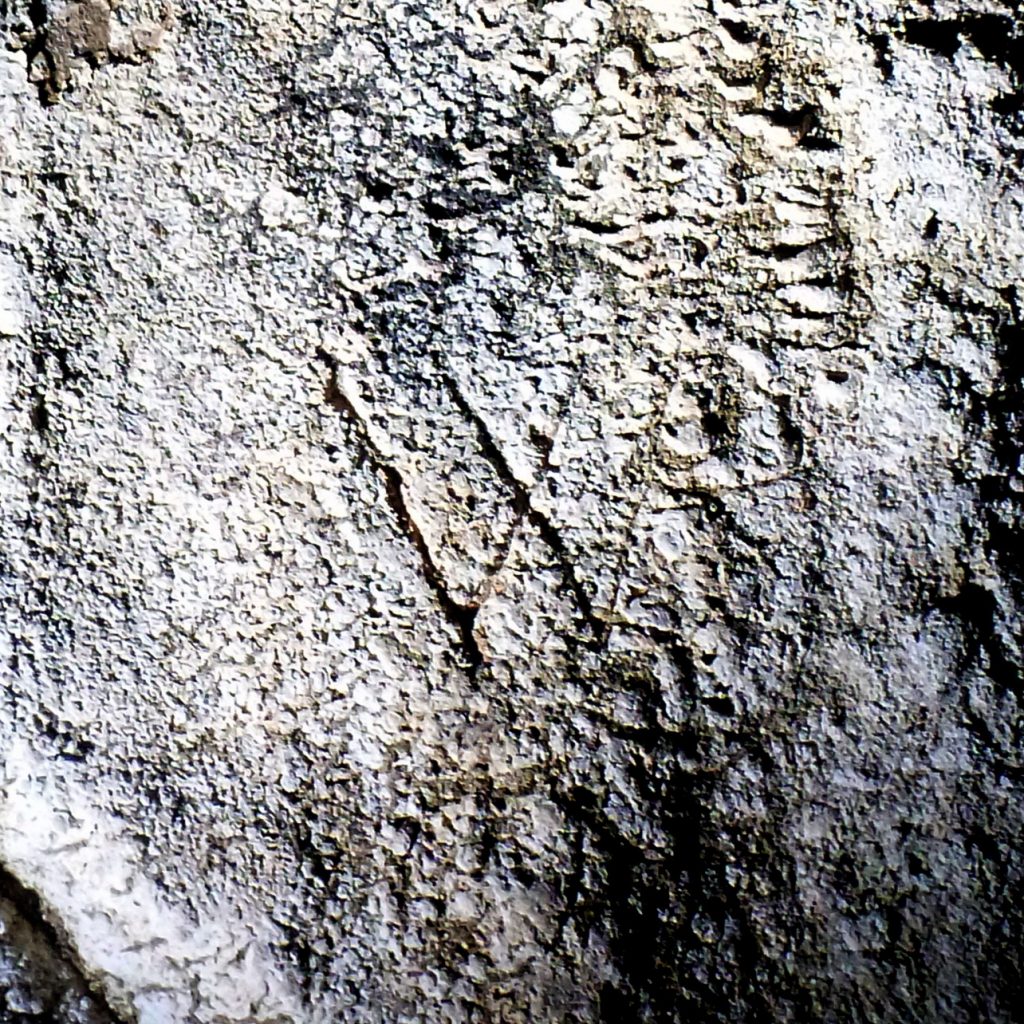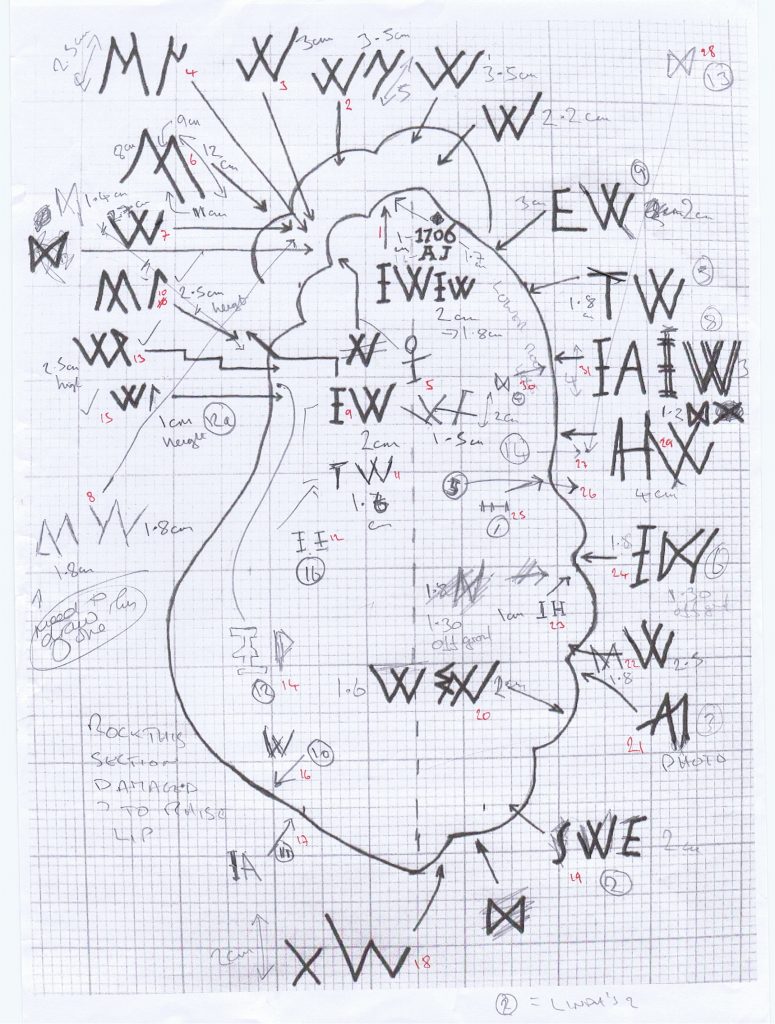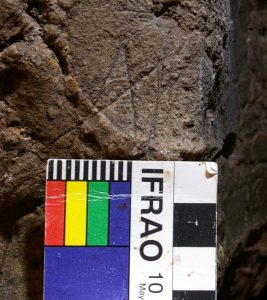Ritual Protection Marks in Caves Under the Mendips

Conservation work in 2003 in Goatchurch Cavern on the Mendips revealed some fine inscribed marks on calcite flowstone next to the Giant’s Steps. The marks resembled the letter W and aroused interest as the patina was considerably darker than the lighter exposed calcite nearby in graffiti dated 1704. We filed them in the mental compartment marked ‘interesting’ but thought no more about them.
Five months later, an article in The Guardian entitled “Scare witch project. Repairs at Kew Palace uncover a tradition of superstition” brought the Goatchurch marks back to mind. The article described “witchmarks” cut into timbers in the palace “to keep witches from flying in at the window or down the chimney”, which had been discovered during recent renovations. The marks were described as “…sun symbols, eye shapes, M-shapes to invoke the protection of the Virgin Mary, classic witchmarks … in the positions near the potential points of danger, the door and window entry points…”
There was an obvious similarity to the markings in Goatchurch. Research quickly revealed that ritual protection marks intended to guard a dwelling against evil spirits are commonly found on timber and stone dating broadly from 1500 onwards. There is a widely accepted belief that the W marks invoke the Virgin Mary and are actually conjoined Vs standing for ‘Virgin of virgins’, from a Marian prayer dating to the late 1500s. Graffiti studies have shown that in terms of quantity, the W symbol is the most numerous by a very large margin and the mark appears to have survived the Reformation, possibly through simply being seen as a generalised good luck symbol, or something to avert evil. The letter M, when found by itself, is also thought to be a Marian mark. The beauty of these marks is that either way up, they read as a protective symbol and so cannot be inverted for evil purposes. The website Apotropaios provides an excellent introduction to this sort of magical protection.

The W marks found in Goatchurch are small and difficult to see without raking light, as the photo shows, but context is often the most important thing in this area of research. There is often a noticeable coldness in the air at the top of the Giant’s Steps caused by a draught of air rising from the lower part of the cave and in that respect, the position of the marks is consistent with those found over chimney lintels. The position of the marks is believed to be the major indicator of their purpose. It seems likely that they were placed there to prevent something of supernatural origin coming out of the depths of the cave, possibly while someone was using the upper part of the cave for shelter. Inscribing protective symbols at that point could have been an attempt to ensure that evil remained confined within the cave.
There is no means of directly dating the marks as there is no overlying coating of stalagmite growth that could be used for dating purposes, but the cave was known locally in 1736, and there is no reason to suppose that the entrance had not been open for some time before that date.

The discovery of ritual protection marks in Goatchurch Cavern opened the possibility of finding such marks in other caves, and one of the next sites investigated was Long Hole in Cheddar Gorge. A check of the avens quickly immediately revealed a mark in a classic situation, high up in a chimney. There’s a very similar mark in the Swan Inn in Worlingworth, Suffolk. Long Hole contains numerous ritual protection marks and historic graffiti.
Another obvious place to investigate was Wookey Hole in Somerset, a cave that’s been associated with witchcraft legends for hundreds of years. A preliminary visit by Chris Binding very quickly revealed a large concentration of engravings, many clearly identifiable as ritual protection marks, clustered in a small aven known to the show-cave guides as The Witch’s Chimney. Their presence in conjunction with an aven came as no surprise. What was a surprise was sheer number and variety of marks and the large concentration in one small area. However, again the location provides much of the necessary explanation. The Witch’s Chimney is a feature the size and shape of a large stone fireplace and a cold convection draught rises, quickly chilling anyone standing in there for any length of time.

The long task of cataloguing the marks revealed several more near the entrance to the cave and, more recently, further examples were found during work on a ‘wild’ caving route for visitors. Again, these marks are all very finely drawn and many can only easily be seen by means of side-lighting from an LED torch. Wookey contains other marks such as a crossed I which could possibly be an abbreviated Christogram. Another symbol found in Wookey Hole is the ‘butterfly cross’ (sometimes liken to the runic Dagaz symbol). The Witch’s Chimney contains numerous marks of this type, commonly found as a protective symbol in dwellings.
A poem written by John Jennings in 1810 provides a connection between the marks in Long Hole and those in Wookey. The poem, called The Mysteries of Mendip, or the Lost Lady, contains a local superstition by which evil spirits can be banished from dwellings, sending them first to Wookey Hole, then to the Cheddar cliffs and lastly to the Red Sea.
“To lay the lorn SPIRIT, you o’er it must pray,
And command it, at length, to be gone far away,
And, in WOOKEY’s deep HOLE,
To be under control
For the space of SEVEN YEARS and a DAY.
If then it return, you must pray and command,
By midnight,
By moonlight,
By Death’s ebon wand,
That to CHEDDAR CLIFFS now, it departeth in peace
And another SEVEN YEARS its sore troubling will cease.
If it return still,
As, I warn you, it will,
To the RED Sea for ever
Command it, and never,
Or noise more or sound
In the House shall be found.”
So, there it is: Exorcism 101, Somerset-style. The poem enables Jennings to record a superstition which he believed to be well known in Somerset. For our purposes, the poem provides a link between Wookey Hole and the caves in the cliffs of Cheddar Gorge, sites in which ritual protection marks have been found. The reference to the Red Sea is curious and there are two possible interpretations. The first, and perhaps most obvious, is that the Red Sea was associated with the drowning of Pharaoh’s army in pursuit of Moses and his followers, and so might have been seen as a place where good triumphed over evil and so was an appropriate place for the containment of troublesome spirits. A second possible explanation for the term is that it might be a reference to the the Hebrew myths that associate Lilith, Adam’s first wife, with the Red Sea, a region where demons are believed to have abounded

The meaning of the various marks, some of which have been illustrated here, has been hotly debated by researchers, with some claims that these types of marks are nothing more than carpenters’ marks or masons’ marks, and that there is no arcane motive for them. However, the discovery of these symbols in caves disproves that theory. In support of this, Professor Owen Davies states in his chapter in the recent book The Materiality of Magic by Dietrich Boschung and Jan M. Bremmer: “If the same symbols crop up on other surfaces, then one can eliminate carpenters’ and masons’ marks and brack marks or timber marks.” He goes on to say: “They [Binding and Wilson] have found incised marks carved into the rock, probably dating from the sixteenth to the eighteenth century….. in contexts that cannot serve any construction or building function.”
Chris Binding and I believe, if you’ll forgive the pun, that we have only just started to scratch the surface of the instances of protective marks in caves and mines, and that the underground world has a very definite part to play in the study of ritual protection marks and other magical practices. A survey is now under way of the graffiti and protection marks in Kent’s Cavern, Torquay and numerous other instances have been reported of possible protective marks in other caves and mines. As interest in the subject grows, we hope to share information widely on this subject, so please get in touch if this interests you and if you have found any marks that you believe might be protective in nature.
Chris and I would like to thank the following for their help in the work: Andrew Atkinson, Graham Mullan, Timothy Easton, Brian Hoggard, Lee Prosser, Owen Davies, Ronald Hutton. For permission to work in the caves, thanks are due to Sir David Wills, Longleat Estates Ltd, Hugh Cornwell (formerly of Cheddar Caves and Gorge) and Daniel Medley of Wookey Hole.
This report is a shortened version of a paper given at the first Hidden Charms conference that took place in Norwich in April 2016. Thanks to John Billingshurst, Jeremy Harte and Brian Hoggard for all their hard work on producing the Proceedings of the conference, which contain a wealth of fascinating information. And for anyone interested in the magical protection of buildings, the second Hidden Charms conference is taking place on 21 April 2018 in the wonderful surroundings of the Medieval Hall, Salisbury, with two special tours of the graffiti in Salisbury Cathedral for conference attendees on 22 April.
References and Further Reading
Kennedy, M. 2004. Scare witch project. Repairs at Kew palace uncover a tradition of superstition. The Guardian, Thursday April 29. p13.
Easton, T., 2000, Ritual Marks on Historic Timber. Third Stone: Archaeology, Folklore and Myth. 38. pp11- 17
Billingshurst, J, Harte, J and Hoggard, B, 2016. Hidden Charms: A conference held at Norwich Castle April 2nd 2016. p. 41
Binding, C.J., Easton,T., and Wilson, L.J., 2005. Ritual protection Marks in Goatchurch Cavern, Burrington Combe, North Somerset. Proceedings of the University of Bristol Spelaeological Society, 23(2) , pp 119-133.
Binding, C.J., and Wilson, L.J., 2010. Ritual protection marks in Wookey Hole and caves in the Cheddar Gorge, Somerset. Proceedings of the University of Bristol Spelaeological Society, 25(1) , pp 47-73
Champion, M. 2015. Medieval Graffiti: The Lost Voice of Britain’s Churches. London. Ebury Press. 253pp.
Davies, O. 1999. A People Bewitched. Witchcraft and Magic in Nineteenth-Century Somerset. Bruton.
Cary, D. M. 1924. Some Ballad-Legends of Somerset. Somerset Folk Press.
Jennings, J. 1810. Poems, consisting of the Mysteries of Mendip etc. London
Davies, O. (2007). The Haunted. A Social History of Ghosts. Palgrave Macmillan. Hampshire.
Davies, O. 2015. The Material Culture of Post Medieval Domestic Magic in Europe: Evidence, Comparisons and Interpretations. In The Materiality of Magic. Eds D. Boschung and J.N. Bremmer
Correspondent: Linda Wilson
This article first appeared on www.darknessbelow.co.uk and is reproduced by kind permission of its editors.
